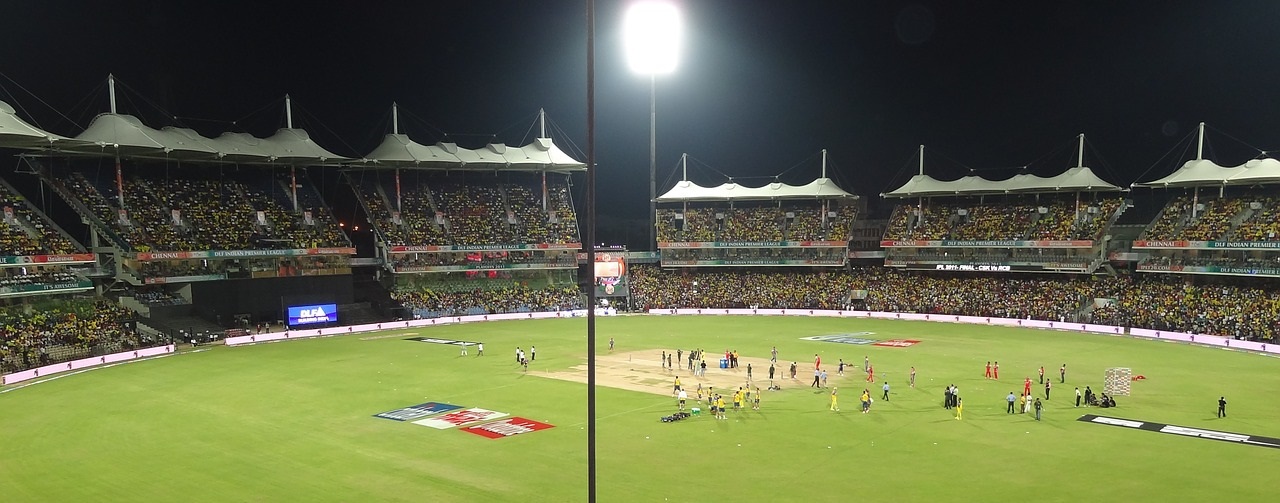MA Chidambaram

M. A. Chidambaram Stadium, commonly known as the Chepauk Stadium, is a cricket stadium in Chennai, Tamil Nadu, India. Established in 1916, it is the second oldest cricket stadium in the country after Eden Gardens in Kolkata. Formerly known as Madras Cricket Club Ground, the stadium is named after M. A. Chidambaram Chettiar, former president of BCCI and Head of TNCA. It is the home ground of the Tamil Nadu cricket team and the Indian Premier League team Chennai Super Kings. Chepauk hosted its first Test match on 10 February 1934, the first Ranji Trophy match in 1936, and the Indian cricket team’s first test victory in 1952 against England. The 1986 India-Australia match held at Chepauk was only the second-ever Tied Test in the history of the game.
Location
The stadium is located at Chepauk, a few hundred meters from Marina beach along the Bay of Bengal. The stadium can be accessed from Wallajah Road in the north, Babu Jagjivanram Road in the west and Pycrofts Road in the south. The stadium is connected through the Chennai Metro by the Government Estate station . It is also connected through the Chepauk MRTS railway station which lies on the Chennai Beach—Velachery section of the Chennai MRTS. The Buckingham Canal runs tangentially to the north side of the stadium.
Chepauk stadium is located across Chepauk Palace, the official residence of the Nawab of Arcot from 1768 to 1855. The stadium site used to be part of the palace grounds of the Chepauk Palace. Three Indo Saracenic style pillars at the entrance of the stadium are the last remnants of the association with the erstwhile palace grounds. The pillars construction are dated back to the rule of Nawab Muhammed Ali Khan Wallaja
History
In 1859, Madras Presidency acquired Chepauk palace in an auction for ₹589,000 In 1865, the government gave permission to build a pavilion at the palace grounds to Madras Cricket Club. The pavilion was finished in 1866. The pavilion was reconstructed in 189 and was utilized till 1982 when it was demolished as part of the stadium renovation
Chepauk Stadium was established in 1916 and has been the home venue of the Tamil Nadu cricket team ever since It is the second oldest cricket stadium in the country after Eden Gardens in Kolkata, still holding all international cricket matches. Bombay Gymkhana being the first is not in use for international cricket.
From 1960 to 1988, Chennai hosted a test match in second week of January and was termed the Pongal Test as the match coincided with the Pongal harvest festival.
Renovation
In June 2009, reconstruction work of the stadium was taken up at the cost of ₹175 crore (US$22 million). The plan consisted of constructing three new reinforced concrete stands designated I, J, and K accommodating 12,000 spectators and 24 hospitality boxes under translucent PTFE membrane roofs. Hopkins Architects, London and Nataraj & Venkat Architects, Chennai were contracted by the Tamil Nadu Cricket Association
The renovation was completed in 2011 and the old roofing with pillars that often blocked the view in the old stadium were replaced by light quad conical roofing held together by cables. The stadium can currently accommodate 50,000 spectators. The stands are at a gradient of 36° and lets the sea breeze in to get the ground’s traditional swing back.
On 31 March 2015, the Supreme Court ruled that the renovation violates regulations relating to public safety. The court ruled that the parts of the renovation which violate the regulations must be demolished and until the appropriate planning permissions are issued and the demolition is complete, three stands (I, J, K) must remain sealed. After their construction, cricket matches took place in the stadium with the I, J, and K stands locked for spectators. The stands were finally de-sealed and opened in March 2020.
In December 2021, the old Anna pavilion, Anna pavilion stand and MCC clubhouse were demolished to make way for a new Anna pavilion and new stands. This is expected to be complete in 2023.
Matches in MA Chidambaram
- India vs West Indies, 42nd Match 2011
- England vs West Indies, 36th Match 2011
- England vs South Africa, 21st Match 2011
- New Zealand vs Kenya, 2nd Match 2011
- Pakistan vs South Africa (Match-26, 2023)
- Pakistan vs Afghanistan (Match-22, 2023)
- Afghanistan vs New Zealand (Match-16, 2023)
- Bangladesh vs New Zealand (Match-11, 2023)
- India vs Australia (Match-5, 2023)



